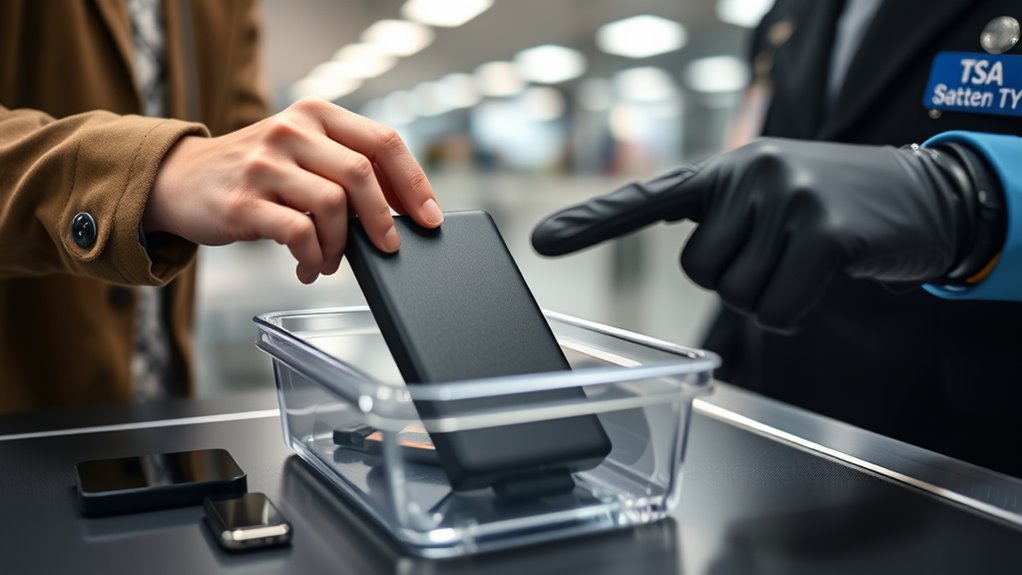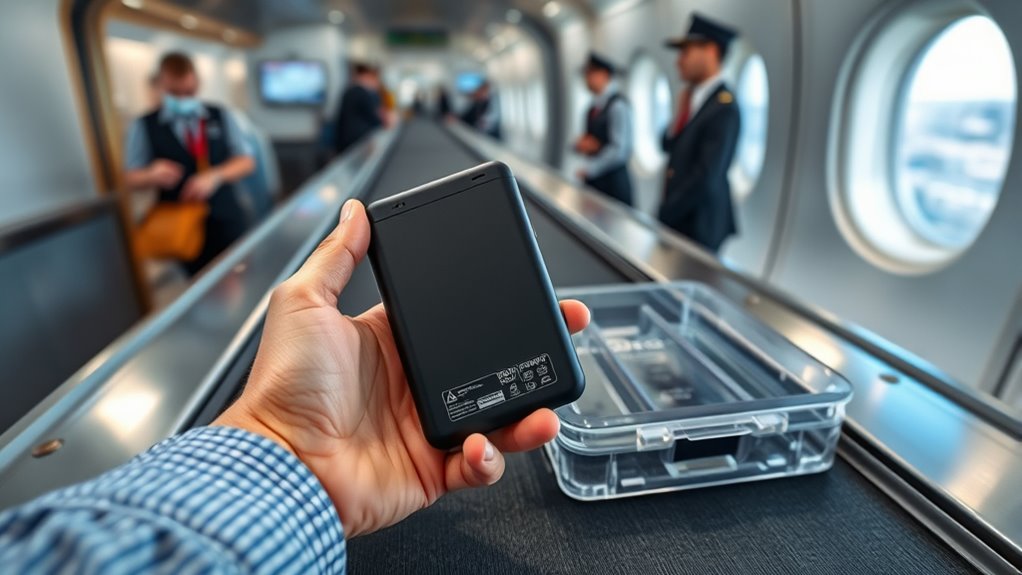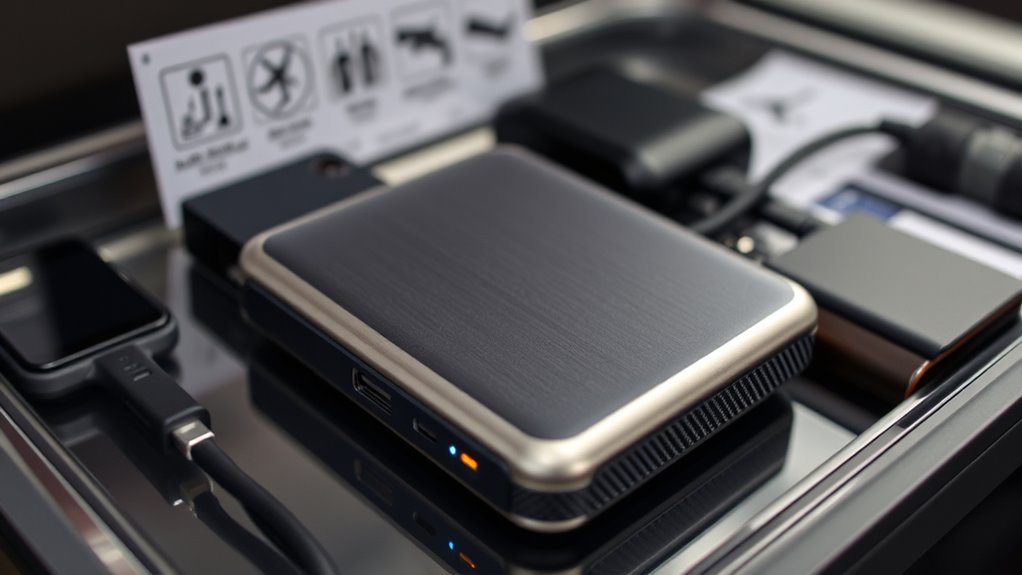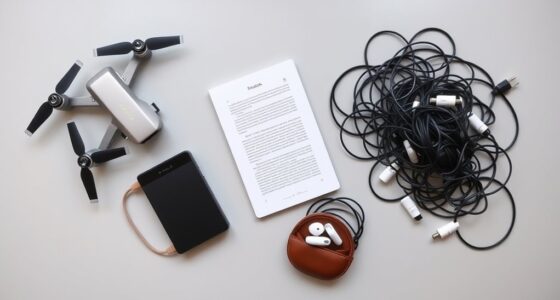When flying with power banks, make sure they’re in your carry-on luggage and comply with airline rules based on capacity. Power banks under 100Wh are usually fine, but those between 100Wh and 160Wh may need approval. Avoid putting batteries over 160Wh on the plane. Keep terminals protected and pack spares carefully. Proper handling and knowing these rules help prevent delays and ensure safe travel. Continue to explore how to stay compliant and travel worry-free.
Key Takeaways
- Carry power banks in your hand luggage, not checked bags, and keep within airline capacity limits (under 100Wh preferred).
- Power banks over 100Wh may require airline approval; avoid exceeding 160Wh to prevent confiscation.
- Fully charge power banks before travel and store terminals protected to prevent short circuits.
- Declare batteries if asked during security checks and pack spares in original packaging.
- Use reputable brands, handle devices carefully, and dispose of old batteries responsibly through recycling programs.
Understanding Airline Regulations for Power Banks

When flying with a power bank, understanding airline regulations is vital to avoid issues at security or boarding. Many airlines have rules about battery recycling and the types of portable charger compatibility they allow onboard. Typically, batteries over 100Wh require airline approval, so check your power bank’s capacity before packing. Adhering to these regulations helps prevent delays and guarantees your device is permitted. Also, consider the importance of battery recycling; some airports provide designated bins for safe disposal of old or damaged batteries, reducing environmental impact. Properly carrying your power bank in your carry-on luggage, not checked baggage, is essential to comply with safety rules. Being aware of these regulations ensures a smooth travel experience and keeps you within airline safety standards. Properly understanding battery capacity limits and industry guidelines can further ensure safe and compliant travel with electronic devices. Additionally, staying informed about regulatory updates can help you adapt to changing airline policies and avoid unexpected issues during travel. Recognizing the history of pinball machines can offer travelers a fascinating glimpse into cultural trends and technological evolution.
Battery Size Limits and Their Impact on Travel

Battery size limits considerably influence your travel plans, as airlines restrict the capacity of power banks you can carry onboard. Airline restrictions specify maximum battery capacity, often measured in watt-hours (Wh), to guarantee safety during flights. Typically, power banks with a capacity up to 100Wh are allowed in carry-on luggage without approval, while those between 100Wh and 160Wh may require airline approval. Larger batteries exceeding 160Wh are generally prohibited. These restrictions impact your choice of power bank, especially if you rely heavily on portable chargers during travel. Knowing the battery capacity limits helps you pack appropriately and avoid delays or confiscation at security checkpoints. By understanding airline restrictions, you can ensure a smooth journey without compromising your power needs.
Packaging and Handling of Power Banks During Flights

To guarantee safety and comply with airline regulations, you should carefully package and handle your power bank during flights. Keep it in your carry-on luggage, never in checked bags, to prevent damage or fire risks. Ensure the power bank is fully charged before your flight, following proper charging procedures—avoid overcharging and unplug once full. When not in use, store the device in a protective case or pouch, minimizing the risk of accidental activation or short circuits. If your power bank has reached the end of its life, dispose of it properly through battery disposal programs, never throw it in regular trash. Handle your power bank gently, avoiding impacts or punctures that could damage the battery and lead to safety hazards. Proper packaging and handling methods help guarantee a safe journey for everyone onboard. Additionally, being aware of battery safety guidelines can further reduce risks during air travel. Familiarizing yourself with Kia Tuning options can also help ensure your vehicle remains safe and compliant after modifications. Always check with your airline for any specific power bank policies to ensure full compliance during your flight. Being informed about power bank capacity limits can help prevent issues at security checkpoints.
Tips for Passing Security Checks With Batteries

Passing security with batteries can be smooth if you prepare ahead. First, keep your batteries in your carry-on luggage, and verify they are within airline regulations regarding capacity. Pack spare batteries in their original packaging or protect terminals to prevent short circuits. Be ready to declare your batteries if asked, especially if they’re large or lithium-ion. Familiarize yourself with airport policies about battery sizes and quantities. If you need to recharge devices during layovers, locate charging stations beforehand to avoid delays. Also, consider the environment—look for battery recycling options at the airport to dispose of used or damaged batteries responsibly. Staying organized and informed helps you pass through security quickly and safely, avoiding unnecessary inspections or delays. Understanding Dad – Amazing Life Together can also inspire patience and positivity during travel. Being aware of safety protocols and battery capacity regulations further ensures a hassle-free screening process. Knowing how to maintain and handle batteries properly can prevent issues during security checks and protect your devices. Additionally, knowing about electric bike power and regulations can be useful if you plan to travel with larger batteries or specialized equipment. Moreover, familiarize yourself with AI-powered security systems that some airports use to enhance safety and efficiency during screening.
Best Practices for Safe Use and Storage of Power Banks on Airplanes

Using power banks safely on airplanes is essential to prevent accidents and guarantee your devices stay charged throughout your trip. Always store your power bank in your carry-on, not in checked luggage, to reduce fire risks. Keep it away from extreme temperatures and direct sunlight, which can damage the battery. When not in use, turn off your power bank and avoid carrying damaged or swollen units. Consider the power bank branding—reputable brands often follow stricter safety standards, making them safer choices. Once home, prioritize battery recycling for old or faulty power banks to prevent environmental harm. Proper storage, safe handling, and choosing trusted brands help ensure safe usage during your flight and beyond, protecting both your devices and fellow travelers. Additionally, educate yourself about sustainable practices to minimize environmental impact and promote eco-friendly habits. Being aware of regulations for batteries on aircraft is also crucial to ensure compliance and safety during your travels. Incorporating power backup safety tips from trusted sources can further reduce risks and enhance your preparedness. Remember that understanding battery safety standards can significantly improve your overall safety while traveling. Regularly checking for updates on airline policies can help you stay informed about any changes in regulations.
Frequently Asked Questions
Can I Carry Multiple Power Banks on the Same Flight?
You can carry multiple power banks on the same flight, but you need to check their battery capacity and charging regulations. Typically, devices with a capacity under 100Wh are allowed in your carry-on without restrictions, but larger ones may require airline approval. Always pack them in your carry-on, not checked luggage, and keep them easily accessible. Be sure to review your airline’s specific rules to avoid any issues at security.
Are Power Banks Allowed in Checked Luggage or Only in Carry-On?
You should carry power banks in your carry-on luggage, not checked bags. Airlines restrict batteries based on capacity and lithium content to prevent fires. Power banks with a capacity over 100Wh, or high lithium content, are typically not allowed in checked luggage. Always check your power bank’s capacity and lithium content before packing, and keep it accessible during your flight to comply with safety regulations.
What Should I Do if My Power Bank Overheats During Flight?
If your power bank overheats during a flight, you should immediately turn it off if possible and inform a flight attendant. They’ll help guarantee battery safety and prevent further overheating. Remember, overheating prevention is key, so avoid exposing your power bank to high temperatures or direct sunlight before flying. Keep it in your carry-on, and never leave it unattended. Acting quickly helps protect everyone’s safety onboard.
Are There Specific Brands or Types of Power Banks That Airlines Prefer?
Think of airlines as gatekeepers for your tech treasure. They prefer brands with proven safety records and clear battery specifications, like Anker or RavPower, because they’re reliable and meet safety standards. Stick to reputable brands, check the battery capacity (usually under 100Wh), and make certain your power bank complies with airline rules. This way, your device stays a trusted companion, not a flying risk, securing smooth travels.
How Do I Identify Airline-Specific Rules for Power Bank Transport?
You should check your airline’s website or contact their customer service to identify airline-specific rules for power bank transport. Look for information on battery capacity restrictions, as airlines often limit watt-hours for carry-on or checked baggage. Also, follow their guidelines on airline-specific packaging, such as using approved containers or proper insulation. Staying informed guarantees you comply with regulations and travel safely with your power bank.
Conclusion
Think of your power bank as a trusted companion on your journey, guiding your devices through the skies safely. By respecting airline rules and handling it with care, you keep the flame of your connection alive without risking the storm of trouble. When you pack wisely and follow safety tips, you’re lighting the way for smooth travels. Remember, a well-managed battery is the steady lighthouse guiding you through your adventure, shining bright and secure.









